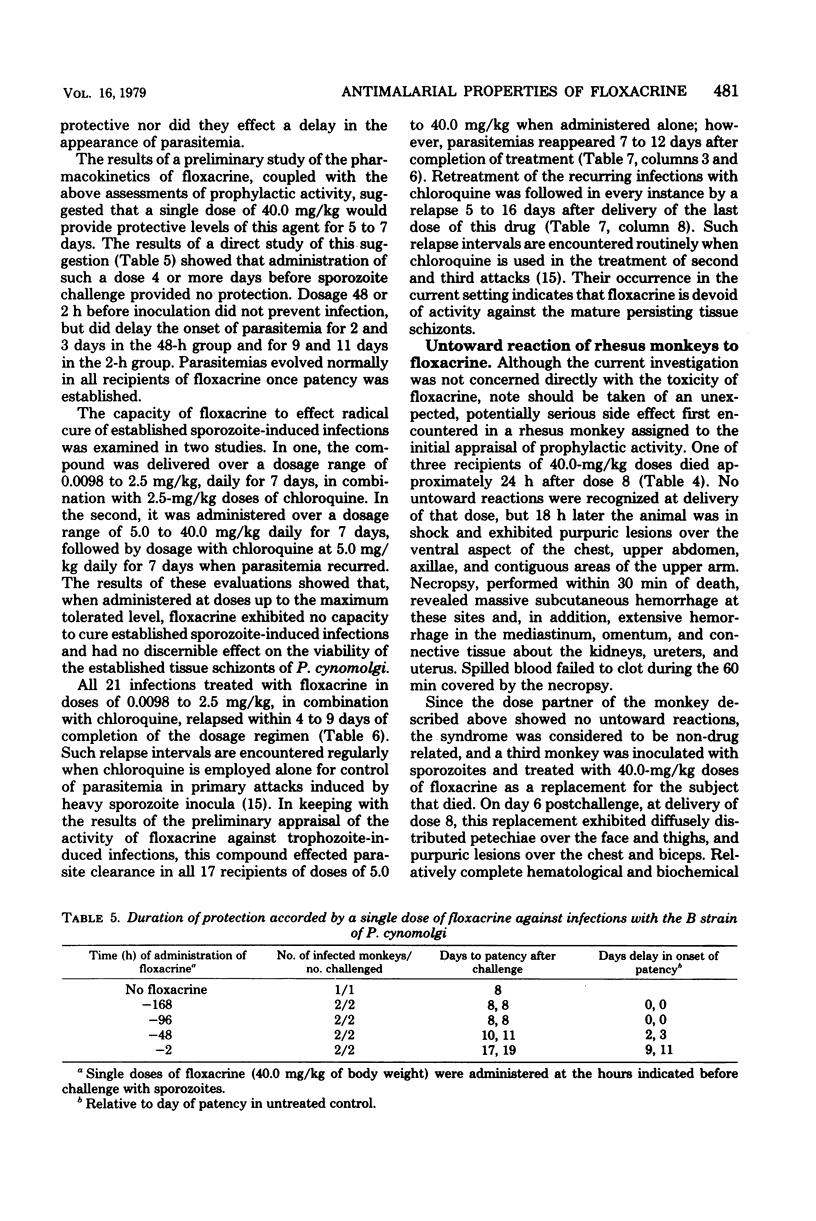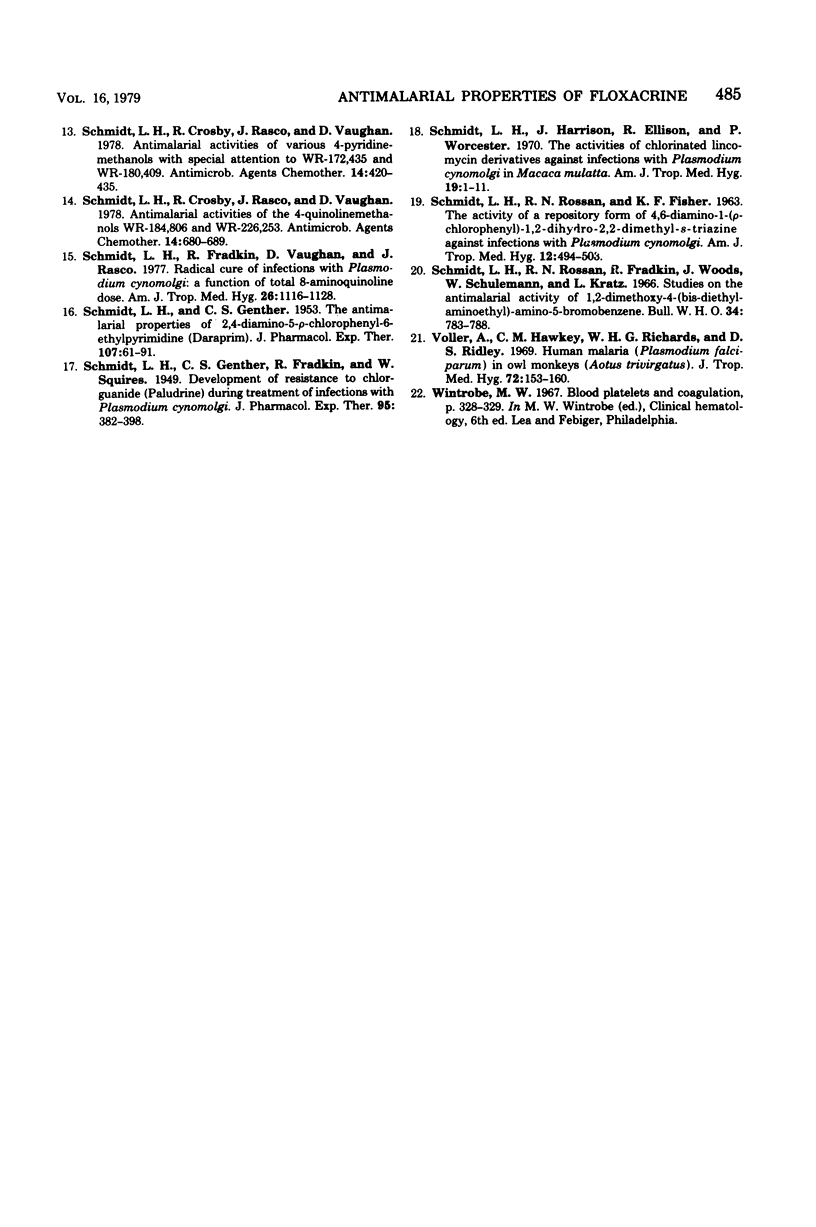Abstract
Evaluations of the activities of floxacrine [7-chloro-10-hydroxy-3-(4-trifluoromethylphenyl)-3,4-dihydroacridine-1,9(2H, 10H)-dione] in owl monkeys infected with trophozoites of a chloroquine-quinine-resistant strain of Plasmodium falciparum, a strain of this plasmodium resistant to both of these quinolines and pyrimethamine, or a strain of P. vivax resistant only to pyrimethamine showed that: (i) this compound regularly effected temporary clearance of parasitemia at daily doses of 1.25 to 2.5 mg/kg; (ii) doses required for the cure of established infections were larger by factors of 6 to 64 than those that effected parasite clearance; (iii) there was more than a 10-fold difference in doses required for the cure of infections with the different strains; and (iv) resistance to floxacrine developed rapidly. Evaluations of the activities of floxacrine in rhesus monkeys challenged with sporozoites of P. cynomolgi showed that: (i) 0.625-mg/kg doses administered daily throughout the incubation period provided complete protection against infection; (ii) single 40.0-mg/kg doses delivered 2 h before sporozoite challenge were without prophylactic activity; and (iii) daily doses of 40.0 mg/kg, the maximum tolerated level, productive of a hemorrhagic syndrome in some subjects, would not cure established infections. These observations suggest that the potential contribution of floxacrine to malaria therapy would be limited to the prophylactic area and for practical reasons would be restricted there by the requirement for daily dosage.
Full text
PDF










Selected References
These references are in PubMed. This may not be the complete list of references from this article.
- SCHMIDT L. H., GENTHER C. S. The antimalarial properties of 2, 4-diamino-5-p-chlorophenyl-6-ethylpyrimidine, daraprim. J Pharmacol Exp Ther. 1953 Jan;107(1):61–91. [PubMed] [Google Scholar]
- SCHMIDT L. H., ROSSAN R. N., FISHER K. F. THE ACTIVITY OF A REPOSITORY FORM OF 4,6-DIAMINO-1(P-CHLOROPHENYL)-1,2-DIHYDRO-2,2-DIMETHYL-S-TRIAZINE AGAINST INFECTIONS WITH PLASMODIUM CYNOMOLGI. Am J Trop Med Hyg. 1963 Jul;12:494–503. doi: 10.4269/ajtmh.1963.12.494. [DOI] [PubMed] [Google Scholar]
- Schmidt L. H., Alexander S., Allen L., Rasco J. Comparison of the curative antimalarial activities and toxicities of primaquine and its d and l isomers. Antimicrob Agents Chemother. 1977 Jul;12(1):51–60. doi: 10.1128/aac.12.1.51. [DOI] [PMC free article] [PubMed] [Google Scholar]
- Schmidt L. H., Cramer D. V., Rossan R. N., Harrison J. The characteristics of Plasmodium cynomolgi infections in various old world primates. Am J Trop Med Hyg. 1977 May;26(3):356–372. doi: 10.4269/ajtmh.1977.26.356. [DOI] [PubMed] [Google Scholar]
- Schmidt L. H., Crosby R., Rasco J., Vaughan D. Antimalarial activities of the 4-quinolinemethanols WR-184,806 and WR-226,253. Antimicrob Agents Chemother. 1978 Nov;14(5):680–689. doi: 10.1128/aac.14.5.680. [DOI] [PMC free article] [PubMed] [Google Scholar]
- Schmidt L. H., Crosby R., Rasco J., Vaughan D. Antimalarial activities of various 4-pyridinemethanols with special attention to WR-172,435 and WR-180,409. Antimicrob Agents Chemother. 1978 Sep;14(3):420–435. doi: 10.1128/aac.14.3.420. [DOI] [PMC free article] [PubMed] [Google Scholar]
- Schmidt L. H., Crosby R., Rasco J., Vaughan D. Antimalarial activities of various 4-quinolonemethanols with special attention to WR-142,490 (mefloquine). Antimicrob Agents Chemother. 1978 Jun;13(6):1011–1030. doi: 10.1128/aac.13.6.1011. [DOI] [PMC free article] [PubMed] [Google Scholar]
- Schmidt L. H., Crosby R., Rasco J., Vaughan D. Antimalarial activities of various 9-phenanthrenemethanols with special attention to WR-122,455 and WR-171,669. Antimicrob Agents Chemother. 1978 Sep;14(3):292–314. doi: 10.1128/aac.14.3.292. [DOI] [PMC free article] [PubMed] [Google Scholar]
- Schmidt L. H., Fradkin R., Vaughan D., Rasco J. Radical cure of infections with Plasmodium cynomolgi: a function of total 8-aminoquinoline dose. Am J Trop Med Hyg. 1977 Nov;26(6 Pt 1):1116–1128. doi: 10.4269/ajtmh.1977.26.1116. [DOI] [PubMed] [Google Scholar]
- Schmidt L. H., Harrison J., Ellison R., Worcester P. The activities of chlorinated lincomycin derivatives against infections with Plasmodium cynomolgi in Macaca mulatta. Am J Trop Med Hyg. 1970 Jan;19(1):1–11. doi: 10.4269/ajtmh.1970.19.1. [DOI] [PubMed] [Google Scholar]
- Schmidt L. H. Infections with Plasmodium falciparum and Plasmodium vivax in the owl monkey--model systems for basic biological and chemotherapeutic studies. Trans R Soc Trop Med Hyg. 1973;67(4):446–474. doi: 10.1016/0035-9203(73)90077-1. [DOI] [PubMed] [Google Scholar]
- Schmidt L. H. Plasmodium falciparum and Plasmodium vivax infections in the owl monkey (Aotus trivirgatus). I. The courses of untreated infections. Am J Trop Med Hyg. 1978 Jul;27(4):671–702. doi: 10.4269/ajtmh.1978.27.671. [DOI] [PubMed] [Google Scholar]
- Schmidt L. H. Plasmodium falciparum and Plasmodium vivax infections in the owl monkey (Aotus trivirgatus). II. Responses to chloroquine, quinine, and pyrimethamine. Am J Trop Med Hyg. 1978 Jul;27(4):703–717. doi: 10.4269/ajtmh.1978.27.703. [DOI] [PubMed] [Google Scholar]
- Schmidt L. H. Plasmodium falciparum and Plasmodium vivax infections in the owl monkey (Aotus trivirgatus). III. Methods employed in the search for new blood schizonticidal drugs. Am J Trop Med Hyg. 1978 Jul;27(4):718–737. doi: 10.4269/ajtmh.1978.27.718. [DOI] [PubMed] [Google Scholar]
- Schmidt L. H., Rossan R. N., Fradkin R., Woods J., Schulemann W., Kratz L. Studies on the antimalarial activity of 1,2-dimethoxy-4-(bis-diethylaminoethyl)-amino-5-bromobenzene. Bull World Health Organ. 1966;34(5):783–788. [PMC free article] [PubMed] [Google Scholar]
- Voller A., Hawkey C. M., Richards W. H., Ridley D. S. Human malaria (Plasmodium falciparum) in owl monkeys (Aotus trivirgatus). J Trop Med Hyg. 1969 Jul;72(7):153–160. [PubMed] [Google Scholar]


